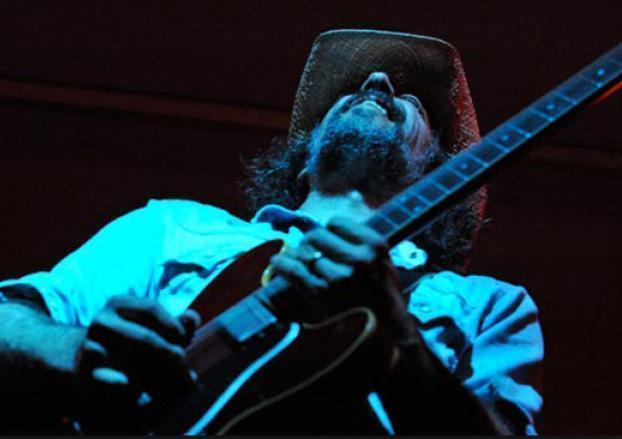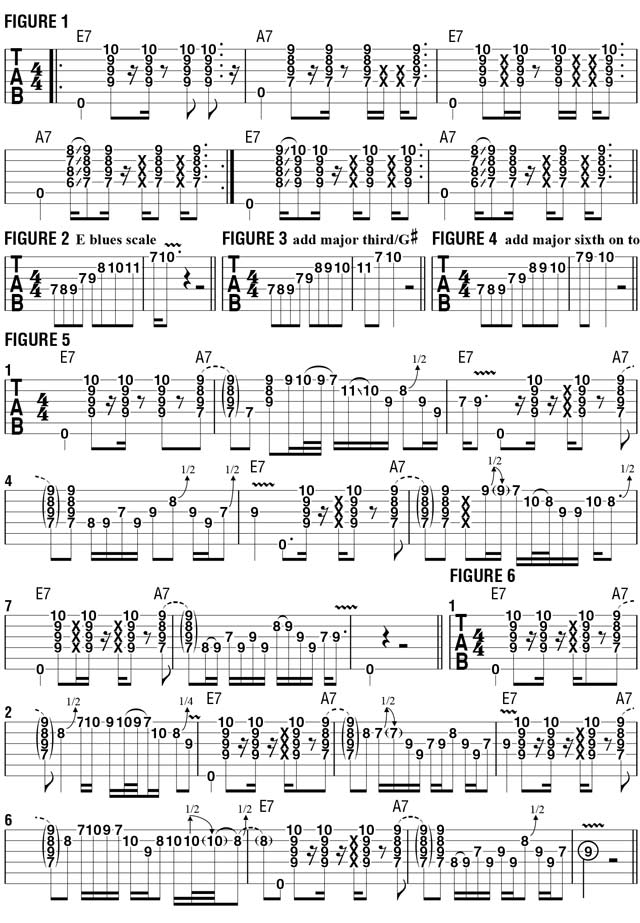Using Chord Positions As a Springboard for Soloing

Over the last two columns, we’ve focused on applying various approaches to two-chord vamps for both rhythm guitar and soloing.
Many players have a difficult time breaking away from commonly used chord shapes when playing rhythm; in truth, moving to new areas of the fretboard for your rhythm parts will also inspire different melodic shapes. Let’s continue our look at a two-chord I-IV (one-to-four) vamp in the key of E, comprised of a repeating, two-bar E7-A7 progression.
Of the many songs built from I-IV progressions, the most common jam tunes are “Turn on Your Love Light,” originally cut by Bobby “Blue” Bland and famously covered by the Grateful Dead, as well as Traffic’s “Feeling Alright” and the Allman Brothers’ “Blue Sky.”
We began our investigation into playing an E7-A7 vamp, with accompanying solo lines, in fifth position and then moved the same approach down to second position. We’ll now do the same thing in seventh and ninth positions. The overall objective here is to become familiar with each fretboard area so that, ultimately, we can move freely from one position to another while playing rhythm and/or soloing, which will add variety to your musical options and performances.
FIGURE 1 illustrates a repeating E7-A7 rhythm part, as played in ninth and seventh positions. Notice that the open low E and A strings are conveniently used as the bass notes for the chords. Allowing the open string to ring with each chord will serve as a pedal tone when solo lines are added in the gaps between the chordal accents.
An effective scale to use for soloing over the dominant seventh-based progression in the key of E is the E blues scale (E G A Bb B D), shown in FIGURE 2 in seventh position, starting from A. Remember that the idea is to add the single-note phrases in the same position as the rhythm part you’re playing.
FIGURE 3 brings the major third, Gs, into the mix, which serves to strengthen the connection to the E7 chord while also presenting greater melodic variation, resulting in an ascending note pattern of A Bb B D E G G# A Bb B D; the descending pattern also places the G natural before the G# in order for the major third, G#, to take intervallic precedence.
We can expand our melodic terrain even further by additionally bringing in the sixth, C#, at the top of our hybrid scale, as illustrated in FIGURE 4, resulting in an ascending pattern of A Bb B D E G G# A Bb B C# D. Now let’s apply these patterns to single-note melodies: in FIGURES 5 and 6, I play an E7 chord at the beginning of each two-bar phrase, adding solo lines following the A7 chord in bars 2, 4, 6 and 8.
Once you have these licks down, try improvising your own original chord-and melody phrases using this same approach.

Get The Pick Newsletter
All the latest guitar news, interviews, lessons, reviews, deals and more, direct to your inbox!
Guitar World Associate Editor Andy Aledort is recognized worldwide for his vast contributions to guitar instruction, via his many best-selling instructional DVDs, transcription books and online lessons. Andy is a regular contributor to Guitar World and Truefire, and has toured with Dickey Betts of the Allman Brothers, as well as participating in several Jimi Hendrix Tribute Tours.








![Joe Bonamassa [left] wears a deep blue suit and polka-dotted shirt and plays his green refin Strat; the late Irish blues legend Rory Gallagher [right] screams and inflicts some punishment on his heavily worn number one Stratocaster.](https://cdn.mos.cms.futurecdn.net/cw28h7UBcTVfTLs7p7eiLe.jpg)


